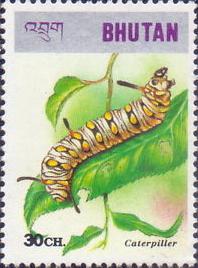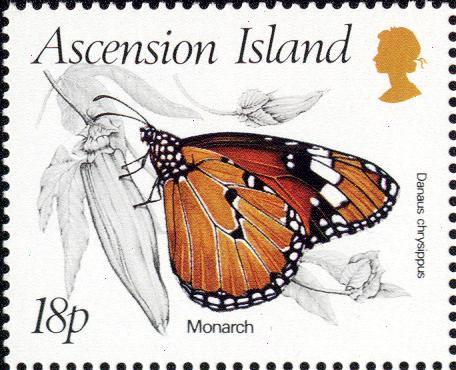
| Plain Tiger (one synonym : Limnas bowringi Moore, 1883) DANAINAE, NYMPHALIDAE, PAPILIONOIDEA | (donherbisonevans@yahoo.com) and Stella Crossley |

Bhutan, 1997

| Plain Tiger (one synonym : Limnas bowringi Moore, 1883) DANAINAE, NYMPHALIDAE, PAPILIONOIDEA | (donherbisonevans@yahoo.com) and Stella Crossley |

Bhutan, 1997
This species was probably named after the philosopher Chrysippus of ancient Greece.
The Caterpillar of this species is banded with black and yellow, and has yellow spots all over. It also has three pairs of filaments which in later instars have red bases.
The caterpillar feeds on various plants that have a poisonous milky sap. The caterpillar appears to retain the poisons in its body making it unpalatable to predators.
It's foods are mainly from the Milkweed family ( APOCYNACEAE ), and include :
The caterpillar grows to a length of about 3 cms. The pupa hangs by its tail from a leaf of the foodplant, and has a length of about 1.5 cms. In life, it is greenish-brown with a golden ring around the thorax. The skin turns brown once the butterfly has left the pupa.

The adult butterflies are orange with wide black borders around the wings, and a variable number of white spots in the black tips of the forewings. The head is black with white spots, and the thorax black with a white dorsal line. The abdomen is brown. The butterflies only have four legs.
The male has a more prominent black markings near the centre of each hind wing. The undersides are similar to the upper surfaces. The wingspan is about 6 cms.
The eggs are pale yellow and bullet-shaped. They are laid singly on young growth of a foodplant.

The species occurs as various subspecies, across southern Europe, Africa, and Asia, including :
and sometimes vagrants blow in to Australia, and have been seen in
and more recently a breeding population has been found in
but many of the 'observations' there may be misidentifications of the Australian native species Danaus petilia. Distinguishing the Australian Danaus petilia from vagrant Danaus chrysippus is possible by noting that in Danaus petilia:
Further reading :
Michael F. Braby,
Butterflies of Australia,
CSIRO Publishing, Melbourne 2000, vol. 2, pp. 593-594.
Carl Linnaeus,
Insecta Lepidoptera,
Systema Naturae,
Volume 1, Edition 10 (1760), Class 5, Part 3, p. 471, No. 81.
John T. Moss,
Focus on the Lesser Wanderer butterfly, Danaus petilia
(Stoll, 1790) Lepidoptera: Danainae: itsname, origins, distribution, hosts, congeners, and mimics,
Butterflies and Other Invertebrates Club,
Metamorphosis Australia,
Issue 88 (March 2018), pp. 1, 4-9.
 caterpillar |  butterflies |  Lepidoptera |  moths |  caterpillar |
(updated 20 January 2011, 13 October 2025)